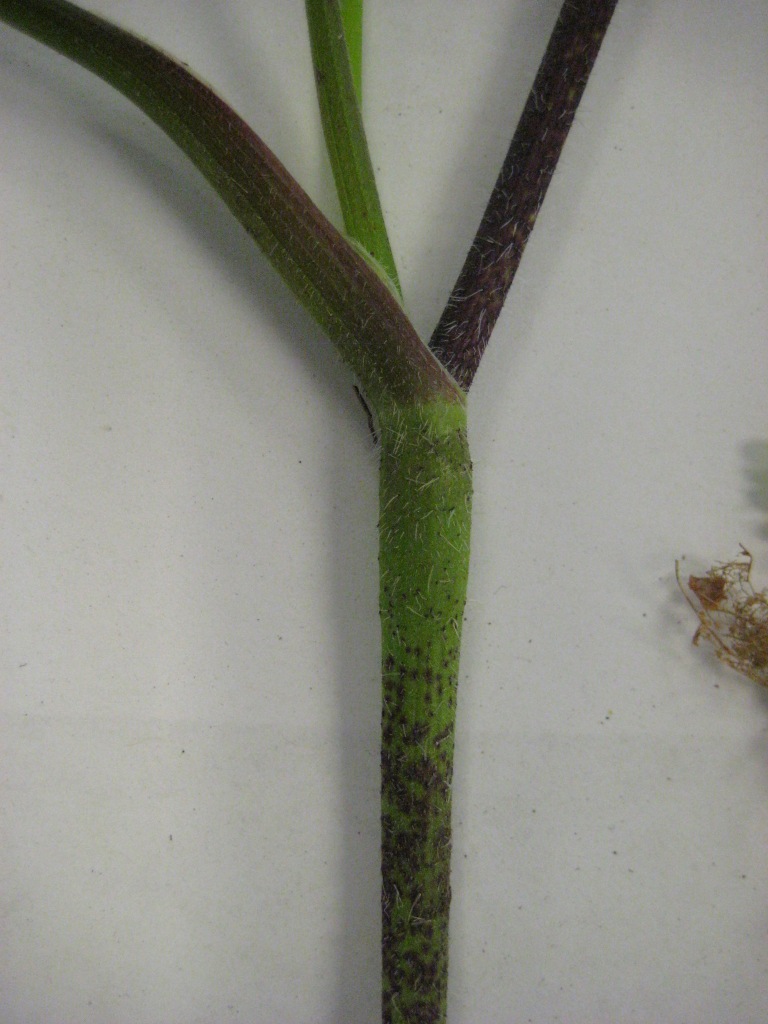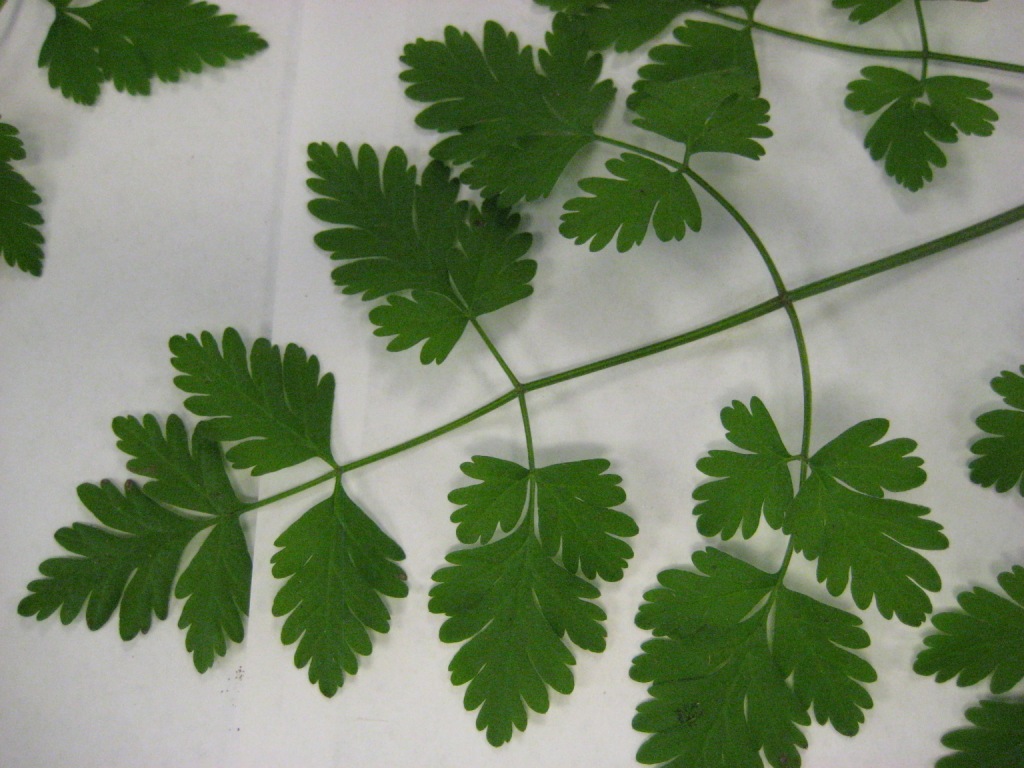Rough chervil identification and control
Chaerophyllum temulum, Apiaceae Family
 Photo by Tom Munsch
Photo by Tom Munsch
Rough chervil (Chaerophyllum temulum) is a European plant that has escaped and naturalized in western Washington. Unlike other plants called chervil, rough chervil is poisonous. It can be distinguished by stems that are hairy and purple-spotted (or sometimes completely purple) and swollen below the stem branches (nodes). It grows to about 3 feet tall and flowers from April to June. Rough chervil is mostly found on edges of forests or other partly shady areas. In King County, it has been found on Vashon Island, the Soos Creek area, and the Cougar-Squak Mountain area.
Legal Status in King County, Washington
 Photo by Tom Munsch
Photo by Tom MunschRough chervil is classified as a Weed of Concern by the King County Noxious Weed Control Board and is not on the Washington State Noxious Weed List. Property owners are not required to control it, although control is recommended in areas being restored to native plants. For more information on the legal status of noxious weeds in King County, see Noxious weed lists and laws.
Identification (see below for additional photos)
- Somewhat hairy biennial plant with lacy leaves and white flowers in umbels
- Grows to about 3 feet tall (39 inches)
- Stems are purple-spotted to completely purple and have rough hairs
- Stems are solid and swollen below the branches (below the nodes)
- Leaves are 2 to 3 times divided into rounded, toothed segments (tri- to bi-pinnately compound), with flattened hairs on leaf surface (somewhat resemble a parsley or cilantro leaf)
- Flowers are in compound umbels (umbrella-shaped clusters) with 6-12 umbellets (smaller umbels)
- Flower stalks (peduncles and pedicels) are hairy
- Flowers are white, 2 mm, with heart-shaped petals and no sepals
- Plants bloom April to June in Washington
- Fruits are oblong, narrowing toward tip, smooth (no burs or spines)
- Look-alikes to rough chervil also found in western Washington:
- UW Burke Museum Image Collection
- Wikipedia - Chaerophyllum temulum
- NatureSpot - Rough Chervil
- Sagebud - Rough Chervil
- iNaturalist - Chaerophyllum temulum


Toxicity
Rough chervil contains a volatile alkaloid chaerophylline, as well as other toxins (mainly in the upper parts and fruits). Externally, the sap of the plant can cause inflammation of the skin and persistent rashes. If consumed, the plant causes gastro-intestinal inflammation, drowsiness, vertigo and cardiac weakness. Human poisonings have seldom been observed, because the plant lacks aromatic essential oils that could lead to its being confused with similar plants used to flavor food. It is, however, used occasionally in folk medicine. Animal poisonings by the plant are commoner than those of humans. Pigs and cattle that have become affected exhibit a staggering gait, unsteady stance, apathy and severe, exhausting colic, ending sometimes in death. (Source: https://en.wikipedia.org/wiki/Chaerophyllum_temulum)
Habitat and impact

Rough chervil is an opportunistic plant which will grow in a variety of situations, from damp places, such as stream edges, to open woodland, woodland edges, road and trail sides, by walls and fences, in both lowland and mid-elevation areas.
Because of its toxicity, rough chervil can cause harm to livestock grazing where it occurs and to people who encounter it while gardening or hiking. Rough chervil can become abundant and dense in disturbed or open areas and spreads quickly by seed. It has the potential to impact native wildflowers that grow in similar habitats.
Growth and reproduction
Rough chervil typically grows as a biennial that takes two years to mature before going to flower, although some plants may flower in both the first and second years. Mowing before plants go to seed may prolong the lifespan of the plant. It reproduces by seed.
Rough chervil typically appears in early spring and flowers from April to June.
Control
Prevention and cultural methods
To prevent the spread of rough chervil, minimize soil disturbance in infested areas from vehicles and machinery and watch roadsides and fence rows for new populations. Disturbed areas should be mulched or re-planted to prevent spread of rough chervil.
Manual control
Mechanical methods
Mowing or weed-whacking before plants flower may reduce seed production but plants may re-grow and flower again later in the season. Make sure not to mow plants when they are in seed to avoid spreading it more.
Chemical control
We are not aware of any information on which herbicides are most effective on this plant. Generally with biennial plants, chemical control is most effective on young plants before they form flowering stems. Because rough chervil leaves are hairy, it may help to use a surfactant to increase effectiveness. If there is any grass present, it is best to use a selective broadleaf herbicide to maintain grass cover, which will help reduce weed seed germination. Make sure to re-seed or mulch after plants die back to avoid leaving bare areas that can be re-infested with this or other weeds.
Know before you spray! Some products are limited to certain sites and land uses and may be restricted in some cases. Always read the label carefully to make sure the product is safe and appropriate for your site and intended land use and for recommended rates and timing for your site. Avoid spraying where there is a chance that herbicide will enter a waterway or wetland unless you are using a state-approved aquatic herbicide and have a permit and license to do so. Some local jurisdictions restrict herbicide use in certain areas, so make sure to refer to the local regulations regarding herbicide use.
Disposal of plant material
Plants can be disposed of in yard waste bins. Do not dispose of plants in natural areas where they can spread from yard waste piles. Burning is not recommended because of the toxins.
For more information or a site-specific recommendation in King County, Washington, contact the noxious weed program. For information in other locations, contact your local weed board or extension office.
Additional information and images of rough chervil
What to do if you find this plant in King County, Washington
Rough chervil is not a regulated noxious weed in King County so property owners aren’t required to control it. However, it is a toxic plant and can become invasive, so it would be helpful to report locations to the property owner or public agency responsible for the area. To report locations online, use our Report a Weed form or download King County Connect, a reporting app available for Android phones.
Rough chervil photos
 Photo by Tom Munsch
Photo by Tom Munsch Photo by Tom Munsch
Photo by Tom Munsch Photo by Tom Munsch
Photo by Tom Munsch Photo by Sasha Shaw
Photo by Sasha Shaw Photo by Ben Legler
Photo by Ben Legler Photo by Erin Haley
Photo by Erin Haley Photo by Sasha Shaw
Photo by Sasha Shaw Photo by Sasha Shaw
Photo by Sasha Shaw Photo by Sasha Shaw
Photo by Sasha Shaw Photo by Sasha Shaw
Photo by Sasha Shaw Photo by Sasha Shaw
Photo by Sasha Shaw Photo by Tom Munsch
Photo by Tom Munsch Photo by Erin Haley
Photo by Erin HaleyReport noxious weeds in King County, Washington
- Please notify us through our online infestation form
Locate noxious weeds in King County, Washington
- Use our interactive noxious weed map
Related information
Related agencies
Program offices are located at 201 S. Jackson St., Suite 600, Seattle, WA 98104. To contact staff, see the Noxious Weed Control Program Directory, send an email, or call 206-477-WEED (206-477-9333).

 Translate
Translate